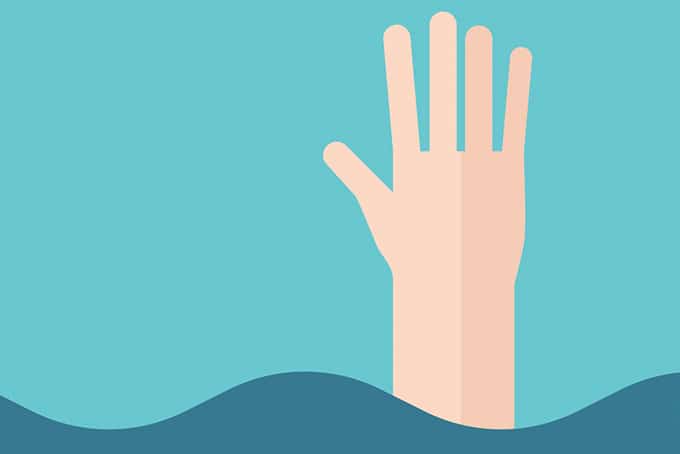
When you’re swimming in several different lines of credit and multiple monthly payments, you may find yourself on the brink of drowning or, at the very least, gasping for air each month until your next payday comes round.
I get it. Many of us find ourselves in this situation. Lingering student loans. Two or three credit cards. A car payment or two. With every new line of credit (usually) comes an attached interest rate and, of course, the accompanying minimum payment every month. Not only does this mean you’ll be forking over more money in interest, you’ll also be juggling multiple payments which can be tricky, not to mention expensive.

If this situation sounds familiar, you might consider debt consolidation, which allows you to pay off all your debts and leave you with only one monthly payment. It’s also likely you can secure a lower interest rate on your new loan which will mean you’ll pay less over time.
If debt consolidation sounds like it might work for you, it’s important to educate yourself about your options so you can choose which strategy best fits with your financial goals.
Below are five options to consider:
- Take out a personal loan. Head to your local bank or credit union for an unsecured loan. Online lenders are also an option. Depending on your credit score, you could lock in a lower interest rate than what you’re paying currently. Remember, the higher your score, the lower your interest. The loan will also come with a set timetable for repayment so you’ll know exactly when you’ll be debt free. Of course, if you secure the loan it’s up to you to make the payments on all your debts. However, if you’re not sure you can be trusted, some online lenders can send the money directly to your creditors to ensure the balances are paid off. It’s also important to remember these loans could come with an origination fee so be aware of not only your interest rate but any additional fees before you commit.
- Transfer your debts to a low-interest or zero-interest credit card. This option is likely a bit easier than applying to your bank or credit union for a loan. Usually, those of us who have qualifying FICO credit scores receive such offers in the mail. However, just because an offer comes in the mail and is easily taken advantage of doesn’t mean it’s the solution for you. Be sure to read the fine print – balance transfer offers usually come with a three percent balance fee so make sure you know how much extra will be tacked onto your transfer. Also, make sure to check the card and the special offer’s terms, including whether or not there’s an annual fee, how long the interest or no-interest rate lasts and what the rate will increase to after the grace period is over. What’s more, if your offer only lasts a year or even 18 months, make sure that’s enough time for you to pay off your debt before additional interest kicks in. All of these numbers should be calculated to determine if this option will save you money in the long run.
- Borrow from a friend or family member. This one can get a little dicey, and the decision to pursue a loan from loved ones is deeply personal. But if you think this might be the way to go, let’s look at how it might play out. For one, there are no credit checks, but you might have some explaining to do about why you need to take care of overwhelming debt, particularly if you’re borrowing from parents. Even if the loan may seem casual, it’s a good idea to set up a simple and, if needed, flexible payment plan both parties agree to. But remember, the best of plans can go awry, particularly when money is involved. Because this option would involve people you love, I advise caution before going this route.
- Borrowing against your home. If you own your home you may be eligible to borrow against whatever equity you’ve built up over time. This loan will come with a fixed interest rate and is usually set for repayment between five and 20 years, usually 10. The advantages to this route are that you don’t need excellent credit to secure the loan and your interest rates will be lower than an unsecured loan from a bank or credit union. However, if you fail to meet the terms of the agreement, your home could be at stake.
- Borrowing from your 401 (k) or IRA. Before I launch into this option please understand this is usually considered a last resort, but it’s still important for you to be aware of the details if the other options won’t work. If you’ve been contributing to a retirement account those funds may be available to you for debt repayment. What’s good is you’re borrowing your own money so the transaction won’t appear on your credit report. Also, there’s no credit check to get the cash, and with a 401 (k) plan you might even be able to avoid penalties on early withdrawal. Make sure to ask if you qualify. However, if you’re younger than 59 ½ years you’ll likely be paying a sizable fee to access the money and you are typically limited to borrowing no more than 50 percent of the total. Furthermore, the money would have to be paid back within five years unless you lose your job or quit and then you’ll be faced with a two-month repayment window. That won’t be easy if you’re unemployed.
Finding yourself in a position where you’re considering consolidating your credit card debt is likely scary. Sussing out your options to dig yourself out of the hole can be confusing. If you need more advice than the options and information listed above, you can always reach out to the team at American Credit Foundation.